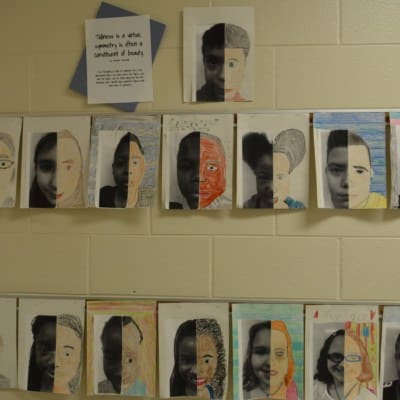Check out this classroom:
It looks just like many of the high school classes I have visited across North Carolina. It also looks like the ones I sat in more than 30 years ago. This is the industrial model of education — also known as “sit and get.” In a report on “Schools of the Future” by David Osborne, Diane Tavenner, the co-founder and CEO of California’s Summit Public Schools, says,
“The industrial model is really driven by adults…. Kids come in, they’re told where to go, where to sit, what they’re going to learn, when they’re going to learn it. You’re on the assembly line. We believe the next generation models are about the students being empowered to drive their own learning.”
Ahead of the curve in North Carolina, Union County Public Schools is pioneering 51 Classrooms of Tomorrow (CoT) with this premise:


Under the leadership of now-retired Superintendent Dr. Mary Ellis and Deputy Superintendent Mike Webb, UCPS has been phasing in its Classrooms of Tomorrow: 12 in 2014, 12 in 2015, and 27 in 2016. Next year, Walter Bickett Elementary will be the first entire school to integrate the Classrooms of Tomorrow in Union County.
The classroom environment
Andrea Savill, a former teacher, is the coordinator of Classrooms of Tomorrow for UCPS. She says the idea was to create flexible learning environments with a “my-size-fits-me” approach because students have different needs.
Share walls are supplied by Platinum Visual Systems. These full-wall magnetic whiteboards offer options for mounting and configurations and are used to allow students to work out their thinking. The furniture is on wheels so the space can be redesigned daily as needed for the instruction with an unlimited number of configurations including large or small circles. The desks accommodate groups and can be raised or lowered to accommodate students who prefer to stand. Teachers don’t have desks and are constantly on the move around the classroom. Optional soft seating and charging stations are available. Audio equipment allows all students to hear clearly — important for all students but especially English Language Learners. Classrooms have multiple touchscreens so all students can see and interact with what is being projected. Webcams allow students to have Google hangouts with experts anywhere in the world, go on virtual field trips, and teachers use them to tape lessons.


Savill says, the classroom environment “is a tool to enhance instruction.” The Classrooms of Tomorrow implement project-based learning, and all teachers receive professional development to help them transition to this student-centered, inquiry-based approach where the teacher is seen not as a “sage on the stage” but as the “guide on the side.”
An elementary school classroom: Marshville Elementary School
In this 4th grade classroom, the teacher-facilitator, Kristen Mantel, says, “We are going to design and build roller coasters out of paper.” The class responds, “OK, let’s do it.” When it comes to project-based learning, Mantel says, “the students feel more like taking risks.” She says it requires teachers to give up control and partner with students in learning.


Parents say, “I wish it was like this when I went to school,” and often bring grandparents to see the new classrooms. Student engagement and attendance have increased, and behavior issues are few and far between.
Caiden says, “We get to talk more and play more instead of sitting down just working. And we have more experiences to learn with each other, to learn new things with each other.”
Here is a student sharing her digital learning portfolio from the year:
A high school classroom: Monroe High School
In this high school math class, Chevy Coffey, the teacher (who also graduated from this high school), is wearing a microphone. Speakers are placed in the ceiling around the classroom strategically so each student can hear her clearly. The desktop audio units allow Coffey to hear the students talking in small groups. She says, “it’s easier to reach every individual, every group. I can hear who knows, who doesn’t.” Coffey says in her classroom collaboration is up with all of the students feeling responsible for each problem since they are able to work collectively.
Coffey realizes from listening in on a small group that students are confusing lengths and angles. She moves from a small group to address the class:
Iterating the Classrooms of Tomorrow
Learning as they go, Savill says the design of the classrooms for elementary, middle, and high schools has evolved along the way. For instance, after Phase I, they made sure all of the interactive display panels were mobile, they right-sized the soft seating, and removed teacher desks. Savill says a UCPS team worked with vendors to custom-design Chromebook carts that also serve as a teacher workstation.
“It’s a learning experience for all of us,” she says.
Savill says the cost of the furniture for the Classrooms of Tomorrow is about $10,000, which she says is comparable to a traditional classroom. Union County has been able to get vendors to subsidize the other components by piloting this approach.
As Mantel finishes helping her students build roller coasters, she notes:


Union County Public Schools: A culture of innovation
Union County Public Schools: Classrooms of Tomorrow
Union County Public Schools: Partners in Learning Collaborative connects philanthropy, policy, and practice
Union County Public Schools: Talent matters
Editor’s Note: SAS and The Goodnight Educational Foundation support the work of EdNC.























